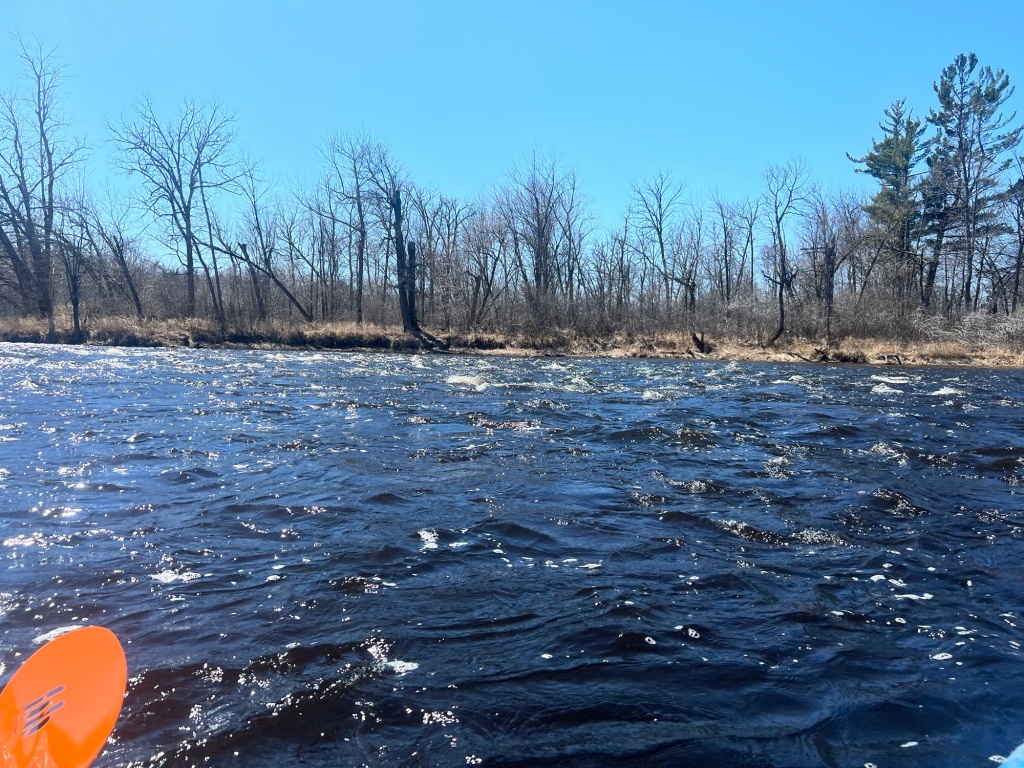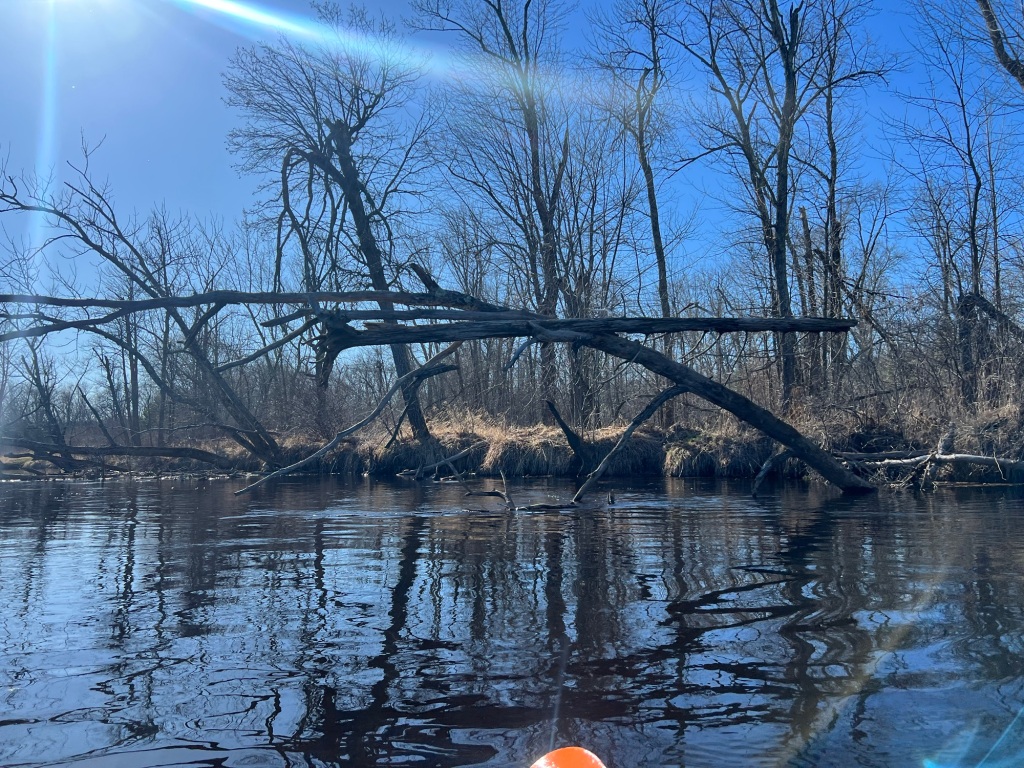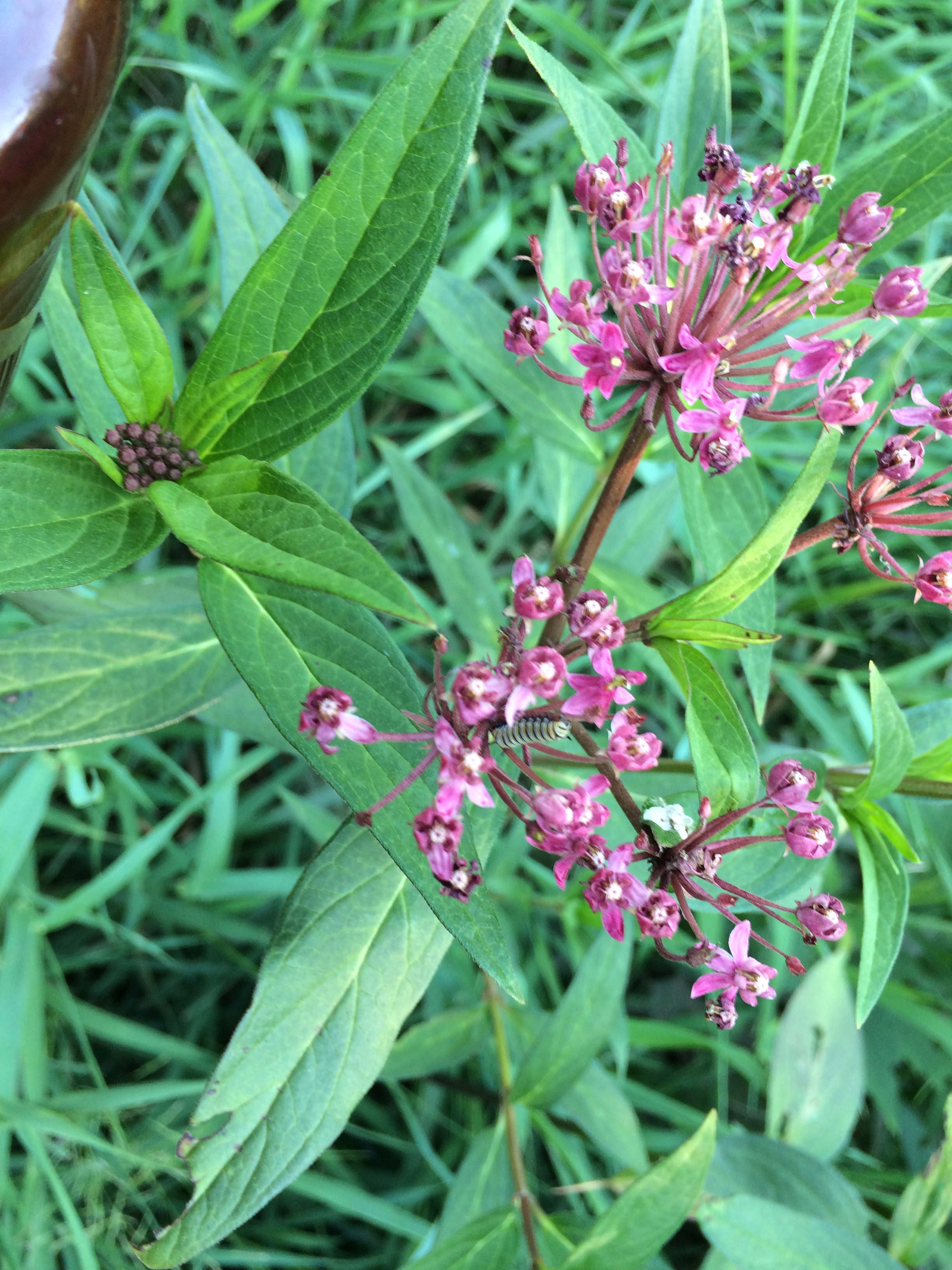It was too nice a weekend to not paddle. And as I learned this winter, there isn’t always what you need to do the sport that you want to do. With skiing, that’s snow. With paddling, that’s water. And water only gets lower as spring moves to other seasons. And when there’s not much snow, and no snowpack, there aren’t spring water levels. The St. Croix has good data for water levels, but it looked ‘average’ – and I don’t mean average for spring, but average, not high. I didn’t want to paddle much for rapids since I was going alone, and didn’t want to get stuck either with ‘average’ water levels. Based on that, and where Ryan was coming from (to shuttle me and bike on his own) I chose to paddle Riverside to Thayer.
I’ve been to Riverside a few times, a takout point for the Namekagon and Totogatic (as there is nothing after the confluence of either of those rivers). I recognized the landing right away, and got my kayak ready for the water. As I neared the water, dragging my boat close, I saw the poison ivy berries haunting me along the edge. It’s really the only reason notice the plant in the winter, a warning to keep my distance!
Once on the river, I took in the fresh air and sunshine. I was soon under the bridge, and as I do, I started naming the plants. There wasn’t much for animals. I came alongside the western bank, talking to my phone (or myself?) to record the plants I was seeing. There was a pretty flower of a shrub (not showy, but showy for a wind-pollinated early spring flower – Myrica I believe). “Who are you” I asked it and…. an animal upstream popped out. What was a porcupine going to do?! It looked at me, wondering who I was. And then my brain came on board, as it slipped into the water, not twenty feet from where I was (though I was floating downstream quickly) – it was a beaver! It slid into the water and swam upstream on the surface, not too bothered by me. So the highlight of the day may have been in the first ten minutes. The third beaver I’ve seen this year. I think I’ve seen three other beavers in my whole life. Interesting, amik is telling me something?


I sat there dazed, surprised that a beaver just came off the shore, looked at me for a few long seconds sizing me up, and swam away. The kayak kept floating downstream. I figured I should get straight with the river, and turned to watch the banks go by. Most of this section had a wide open floodplain, with some higher hills on the east. There are some rapids shown about 2 miles in, and I wondered if they would be rapids, as sometimes they overemphasize rapids on the maps to keep people safe. I could eventually see them ahead, they made noise, and I was a bit nevous. In the end, they were not much. Riffles to class 1.


Overall, this section is slow and wide. There isn’t a lot of note along the way. There are some islands that you go by in some parts. (I hadn’t checked all my books prior to the paddle, Pansy Landing is noted in my books, about 4 miles in, but is not mentioned in the NPS maps. I was not looking for it and didn’t see it.) There are a few campsites (I stopped at the one by Crystal Creek (125.5) and it seemed like a quaint site right by the creek). As the river nears Danbury, you can see the town. You can hear some cars too, but it’s not a super busy highway. Interestingly, I noticed the birdsong picked up as I turned the corner and could see Danbury. Having paddled the Yellow River, I believe that there is a landing right at the confluence that isn’t on the map. (Checking my ‘Paddling Northern WI’ book, it does show a landing there. An older NPS map shows that it’s a landing that has a few and I noted that it’s a tribally owned landing). There were some people fishing below the bridge over the Yellow. It didn’t look like a river that could be paddled from where I was at, but I do know that I came out there!
The river goes under the Gandy Dancer Trail (an old railroad bridge) and heads away from town, wide and slow still. It got windy on this part, but I kept my pace and the wind wanted me go go upstream. It did let up, and I could finally check the map. I passed a campsite with a torn up sign at it. I thought I was further than I was. The site was probably right near the Lower Tamarack River. I soon passed Lower Tamarack Landing, first a dead end with an eroded riverbank, and then the actual landing with a sign, and realized that the campsite was likely one destroyed by the flooding a few years ago. The campsite on the map is after the landing.

I knew I was getting close now, and Ryan said to let him know when I could see the Highway 77 bridge. Of course, with a mile left, my cell servi ce disappeared (which maybe I remember from these parts on other trips). I saw the bridge ahead and knew that there was a rapid/ledge right before the bridge and to stay on the Wisconsin side of the river (the NPS map had that written on it). I did finally get a text through, stayed left, and saw Ryan come under the bridge to get my picture as I finished. I knew this landing too, I had waited here for Ryan to shuttle for another recent trip. It was a beautiful day to get out on the river, in a spring that won’t yield a lot of snowmelt. It’s a good paddle for lower water levels!
Other beings seen include: Reed canary grass, aspen, red oak, burr oak, sand barrens, red-osier dogwood, poison ivy, ash, hazelnut, white pine, blue dragonfly, silver maple, turkey vultures, wood duck, red maple eagle, merganser, mallard, frogs croaking, juvenile eagle, redwing blackbird, dead elm, swamp milkweed, baby nettles, raven, painted and soft shell turtles, smartweed, tamarack, white birch
Paddled April 14, 2024
I used NPS maps for this section. I also have a few others for reference but didn’t read up prior to the paddle.
Weather: sunny, 60s, windy
Time paddling: 3.75 hours
Water level: 1860 cfs near Danbury














































 The next day, we paddled ~4 miles to Phipps Flowage and camped at Site 73.6. It was a very rainy evening. Again it was a smaller site, and we were able to stay dry between our tents and a tarp. The picnic table was n an open area, so we were not able to gather at it during the rain (and it was chained down). We pulled one of our canoes to the top of the steep ridge we were on, and were able to stack the rest away from the water at the take-out site. The site was very shady in the morning so most of our belongings didn’t dry out. Bear trees abounded and there was a beautiful meadow down the trail from the toilet.
The next day, we paddled ~4 miles to Phipps Flowage and camped at Site 73.6. It was a very rainy evening. Again it was a smaller site, and we were able to stay dry between our tents and a tarp. The picnic table was n an open area, so we were not able to gather at it during the rain (and it was chained down). We pulled one of our canoes to the top of the steep ridge we were on, and were able to stack the rest away from the water at the take-out site. The site was very shady in the morning so most of our belongings didn’t dry out. Bear trees abounded and there was a beautiful meadow down the trail from the toilet.

 Our last full day on the river, we paddled 10.9 miles to Site 52.1. The river is swift here and it doesn’t take too long for over 10 miles. The tricky part of the river was the island right before the site. If you want to go to Site 52.6, make sure to go left at the big island. Otherwise, you will have to paddle upstream a little ways to get to it. Our campsite was great. There was a long path up to it, and it was very spacious. There is lots of poison ivy at this site, especially to the right side of the landing. There is a short stairway to bring boats up and lots of space right by the water to store them. Again, careful of the poison ivy! There are logs to sit by the fire and lots of space for tents. The sun rose over the river and was beautiful!
Our last full day on the river, we paddled 10.9 miles to Site 52.1. The river is swift here and it doesn’t take too long for over 10 miles. The tricky part of the river was the island right before the site. If you want to go to Site 52.6, make sure to go left at the big island. Otherwise, you will have to paddle upstream a little ways to get to it. Our campsite was great. There was a long path up to it, and it was very spacious. There is lots of poison ivy at this site, especially to the right side of the landing. There is a short stairway to bring boats up and lots of space right by the water to store them. Again, careful of the poison ivy! There are logs to sit by the fire and lots of space for tents. The sun rose over the river and was beautiful!



 The West Fork of the Chippewa River was an adventure I took with a Natural Resources Foundation (NRF) field trip led by the Couderay Waters Regional Land Trust.The leaders taught us about fish populations here (we got to participate in seining fish) and some history of the river. I would highly suggest a trip with the NRF if you get a chance:
The West Fork of the Chippewa River was an adventure I took with a Natural Resources Foundation (NRF) field trip led by the Couderay Waters Regional Land Trust.The leaders taught us about fish populations here (we got to participate in seining fish) and some history of the river. I would highly suggest a trip with the NRF if you get a chance: 


